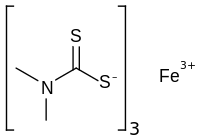 | |
3tight.gif) | |
| Names | |
|---|---|
| IUPAC name Tris(dimethyldithiocarbamato)iron | |
| Other names Ferric dimethyl dithiocarbamate, Ferbam | |
| Identifiers | |
3D model (JSmol) |
|
| ChEBI | |
| ChemSpider | |
| ECHA InfoCard | 100.034.970 |
| EC Number |
|
| KEGG | |
PubChem CID | |
| RTECS number |
|
| UNII | |
| UN number | 3077, 2771 |
CompTox Dashboard (EPA) | |
InChI
| |
SMILES
| |
| Properties | |
Chemical formula | [(CH3)2NCS2]3Fe |
| Molar mass | 416.5 g/mol |
| Appearance | Dark brown to black, odorless solid[1] |
| Density | 1.52 g/cm3 |
| Melting point | Decomposes above 180 °C (356 °F)[1] |
| Boiling point | Decomposes[1] |
| 0.01% (20 °C)[1] | |
| Hazards | |
| Main hazards | Reacts with strong oxidizers, moisture[1] |
| Lethal dose or concentration (LD, LC): | |
LD50 (median dose) | 3000 mg/kg (rabbit, oral) 2000 mg/kg (guinea pig, oral) 1130 mg/kg (rat, oral) 3400 mg/kg (mouse, oral)[2] |
| NIOSH (US health exposure limits): | |
PEL (Permissible) | TWA 15 mg/m3[1] |
REL (Recommended) | TWA 10 mg/m3[1] |
IDLH (Immediate danger) | 800 mg/m3[1] |
Except where otherwise noted, data are given for materials in their standard state (at 25 °C [77 °F], 100 kPa). | |
Iron tris(dimethyldithiocarbamate) is the coordination complex of iron with dimethyldithiocarbamate with the formula Fe(S2CNMe2)3 (Me = methyl). It is marketed as a fungicide.[3]
Synthesis, structure, bonding
Iron tris(dithiocarbamate)s are typically are prepared by salt metathesis reactions.[3]
Iron tris(dimethyldithiocarbamate) is an octahedral coordination complex of iron(III) with D3 symmetry.[4]
Spin crossover (SCO) was first observed in 1931 by Cambi et al. who discovered anomalous magnetic behavior for the tris(N,N-dialkyldithiocarbamatoiron(III) complexes.[5] The spin states of these complexes are sensitive to the nature of the amine substituents.[6]
Iron tris(dithiocarbamate)s characteristically react with nitric oxide to give Fe(dtc)2NO. This efficient chemical trapping reaction provides a means to detect NO.[7]
Reflecting the strongly donating properties of dithiocarbamate ligands, iron tris(dithiocarbamate)s oxidize at relatively mild potentials to give isolable iron(IV) derivatives [Fe(S2CNR2)3]+.[8]
Safety
The U.S. Occupational Safety and Health Administration (OSHA) has set the legal (permissible exposure limit) for ferbam exposure in the workplace as 15 mg/m3 over an 8-hour workday. The U.S. National Institute for Occupational Safety and Health (NIOSH) has set a recommended exposure limit (REL) of 1 mg/m3 over an 8-hour workday. At levels of 800 mg/m3, ferbam is immediately dangerous to life and health.[1]
See also
- Zinc dimethyldithiocarbamate - a related dimethyldithiocarbamate complex of zinc
- Nickel bis(dimethyldithiocarbamate) - a related dimethyldithiocarbamate complex of nickel
- Iron tris(diethyldithiocarbamate) - a related dimethyldithiocarbamate complex of zinc
References
- ^ a b c d e f g h i NIOSH Pocket Guide to Chemical Hazards. "#0286". National Institute for Occupational Safety and Health (NIOSH).
- ^ "Ferbam". Immediately Dangerous to Life and Health Concentrations (IDLH). National Institute for Occupational Safety and Health (NIOSH).
- ^ a b D. Coucouvanis. "The Chemistry of the Dithioacid and 1,1-Dithiolate Complexes". Progress in Inorganic Chemistry. 11: 233–371. doi:10.1002/9780470166123.ch4.
- ^ J.Albertsson, Å. Oskarsson). "Compounds with intermediate spin. I. The crystal structure of tris(N,N-dimethyldithiocarbamato)iron(III) at 150 and 295 K". Acta Crystallographica Section B. 33: 1871–1877. doi:10.1107/s0567740877007237.
- ^ L. Cambi; L and L. Szego (1931). "Über die magnetische Susceptibilität der komplexen Verbindungen". Chem. Ber. Dtsch. Ges. 64 (10): 2591. doi:10.1002/cber.19310641002.
- ^ P. Gütlich; H.A. Goodwin (2004). Spin Crossover in Transition Metal Compounds I. Springer Berlin. ISBN 978-3-540-40396-8.
- ^ Fujii, S.; Yoshimura, T. (2000). "A new trend in iron–dithiocarbamate complexes: as an endogenous NO trapping agent". Coordination Chemistry Reviews. 198: 89–99. doi:10.1016/S0010-8545(99)00196-4.
- ^ Pasek, E. A.; Straub, D. K. (1972). "Tris(N,N-disubstituted Dithiocarbamato)iron(IV) Tetrafluoroborates". Inorganic Chemistry. 11: 259–263. doi:10.1021/ic50108a012.